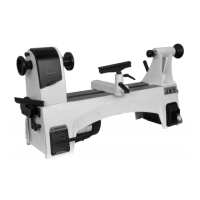11
replacement of the electric cord or plug is
necessary, do not connect the equipment-
grounding conductor to a live terminal.
Check with a qualified
electrician or service personnel if the
grounding instructions are not completely
understood, or if in doubt as to whether the
tool is properly grounded. Failure to comply
may cause serious or fatal injury.
Use only 3-wire extension cords that have 3-prong
grounding plugs and 3-pole receptacles that accept
the tool's plug.
Repair or replace damaged or worn cord
immediately.
2. Grounded, cord-connected tools intended for
use on a supply circuit having a nominal rating less
than 150 volts:
This tool is intended for use on a circuit that has an
outlet that looks like the one illustrated in A, Figure
7-1. An adapter, shown in B and C, may be used to
connect this plug to a 2-pole receptacle as shown
in B if a properly grounded outlet is not available.
The temporary adapter should be used only until a
properly grounded outlet can be installed by a
qualified electrician. This adapter is not permitted
in Canada. The green-colored rigid ear, lug, and
the like, extending from the adapter must be
connected to a permanent ground such as a
properly grounded outlet box.
Figure 7-1
7.2 Extension cords
The use of extension cords is discouraged. Try to
position equipment within reach of the power
source. If an extension cord becomes necessary,
be sure to use one heavy enough to carry the
current your product will draw. An undersized cord
will cause a drop in line voltage resulting in loss of
power and overheating. Table 2 shows correct size
to use depending on cord length and nameplate
ampere rating. If in doubt, use the next heavier
gauge. The smaller the gauge number, the heavier
the cord.
Ampere
Rating
Volts
Total length of
cord in feet
More
Than
Not
More
Than
120 25 50 100 150
AWG
00 06 18 16 16 14
06 10 18 16 14 12
10 12 16 16 14 12
12 16 14 12
Not
Recommended
Extension Cord Recommendations
Table 2
8.0 Adjustments
Make sure all levers and
locking handles are tightened before operating
the lathe.
8.1 Tool rest
Refer to Figure 8-1:
The tool rest assembly is designed to allow
adjustment for height, position on the bed, and
angle to the work.
Loosen locking handle (A) on tool rest base to slide
base forward or back, and to angle it to the bed.
Tighten locking handle firmly before operating
lathe.
Loosen small handle (B) to raise or lower tool rest
and angle it to the work. Tighten handle before
operating lathe.
Figure 8-1

